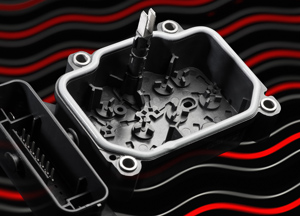BASF
Expanded hydrolysis-resistant PBT portfolio for e-car components / Improved processing
 BASF has released a new generation of hydrolysis-resistant “Ultradur” PBT materials (Photo: BASF) |
Responding to demand from the automotive industry for highly effective sensors for electric mobility and driverless vehicles, BASF (Ludwigshafen / Germany; www.basf.com) has introduced a new generation of its “Ultradur” HR hydrolysis-resistant polyester for which it claims improved processing and higher flowability. An orange grade will now be produced for components in electric vehicles. Since launching the expanded range, BASF said it has developed “around a dozen” HR-modified Ultradur grades with 15%, 30% and 50% glass fibre reinforcement.
New or improved products in the range include Ultradur B4330 G6 HR High Speed with 30% glass fibre reinforcement, which the German chemicals and plastics giant describes as particularly flowable and laser markable, as well as B4330 G10 HR, a highly reinforced grade with 50% glass fibre, and B4331 G6 HR, billed as “the next generation” with optimised processing characteristics. The latter is available as uncoloured, in a black laser markable version and in orange for components in electric cars.
BASF said the highly resistant PBT materials are especially suitable for use in challenging environments, especially as they have a considerably increased resistance to alkaline media that can trigger stress corrosion cracking. Thanks to the unusually high tracking resistance for PBT, plug-in connectors can be designed smaller and still withstand the higher voltages in electric vehicles, so that converters can save on costs and component weight.
For selected automotive applications, BASF has developed Ultradur B4450 G5 HR, which is reinforced with 25% glass fibre, RoHS-compliant and flame retardant. The product showed low fogging values in VDA 278 emission tests, and can be made in light colours and laser-printed. Its property profile is geared towards e-vehicles that have enhanced safety requirements and operate with stronger electrical current than those found in conventional drive trains.
New or improved products in the range include Ultradur B4330 G6 HR High Speed with 30% glass fibre reinforcement, which the German chemicals and plastics giant describes as particularly flowable and laser markable, as well as B4330 G10 HR, a highly reinforced grade with 50% glass fibre, and B4331 G6 HR, billed as “the next generation” with optimised processing characteristics. The latter is available as uncoloured, in a black laser markable version and in orange for components in electric cars.
BASF said the highly resistant PBT materials are especially suitable for use in challenging environments, especially as they have a considerably increased resistance to alkaline media that can trigger stress corrosion cracking. Thanks to the unusually high tracking resistance for PBT, plug-in connectors can be designed smaller and still withstand the higher voltages in electric vehicles, so that converters can save on costs and component weight.
For selected automotive applications, BASF has developed Ultradur B4450 G5 HR, which is reinforced with 25% glass fibre, RoHS-compliant and flame retardant. The product showed low fogging values in VDA 278 emission tests, and can be made in light colours and laser-printed. Its property profile is geared towards e-vehicles that have enhanced safety requirements and operate with stronger electrical current than those found in conventional drive trains.
08.08.2018 Plasteurope.com [240331-0]
Published on 08.08.2018

 German version of this article...
German version of this article...